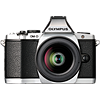Main
Model
Price
Advantages
launch
Announced
Body type
Camera subcategory
Sensor
Effective pixels
Max resolution
Sensor size
Sensor type
Processor
Image ratio w:h
Sensor photo detectors
Image
ISO
White balance presets
Custom white balance
Image stabilization
Uncompressed format
Boosted ISO (minimum)
Boosted ISO (maximum)
JPEG quality levels
Photography features
Minimum shutter speed
Maximum shutter speed
Aperture priority
Shutter priority
Manual exposure mode
Subject / scene modes
Built-in flash
External flash
Flash modes
Continuous drive
Self-timer
Metering modes
Exposure compensation
AE Bracketing
WB Bracketing
Flash range
Screen / viewfinder
Articulated LCD
Screen size
Screen dots
Touch screen
Screen type
Live view
Viewfinder type
Viewfinder coverage
Viewfinder magnification
Viewfinder resolution
Videography features
Resolutions
File Format
Microphone
Speaker
Optics & Focus
Autofocus
Digital zoom
Manual focus
Number of focus points
Lens mount
Focal length multiplier
Physical
Weight (inc. batteries)
Dimensions
Environmentally sealed
Battery
Battery details
Battery Life (CIPA)
Storage
Storage types
Connectivity
USB
HDMI
Wireless
Remote control
Wireless notes
Other features
Timelapse recording
GPS
Orientation sensor
GPS notes
Samples
Videos
Summary
The X-T1 highest resolution of 4896 x 3264 pixels (16 megapixels) is better than the OM-D E-M5 highest resolution of 4608 x 3456 pixels (16 megapixels). The X-T1 is equipped with larger sensor compared to the OM-D E-M5: APS-C (23.6 x 15.6 mm) versus Four Thirds (17.3 x 13 mm). It is very important difference between these cameras because big sensor allows the photographer to shoot photos of the more professional quality. The X-T1 offers a wider ISO range of 200-6400 than 200-25600 ISO range of the OM-D E-M5. Such ISO range let the photographer to shoot good quality photos in dim light situations.
The X-T1 screen is better as it offers more number of screen dots 1,040,000 in compare to 610,000 dots of the OM-D E-M5 screen. The higher dot count screen is better for reviewing pictures on your camera. The OM-D E-M5 is equipped with a touch screen. The OM-D E-M5 offers better lowest shutter speed - 60 seconds.
The Fujifilm X-T1 is equipped with built-in Wi-Fi that will help the photographer to transfer photos quick and easy. The OM-D E-M5 weighs 425g that is 15g less than the weight of the Fujifilm X-T1. The Fujifilm X-T1 can utilize optional accessory GPS devices. Recording GPS data can be useful if you like to travel, to be able to go into the picture metadata and see exactly where an image was taken.
Taking into account the above-mentioned differences the Fujifilm X-T1 will be the best choice. Get the lowest price on Amazon.


